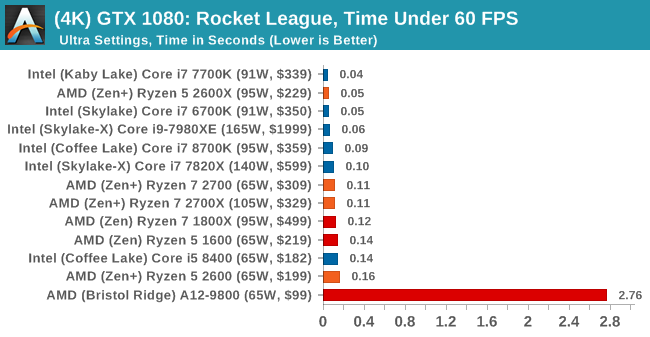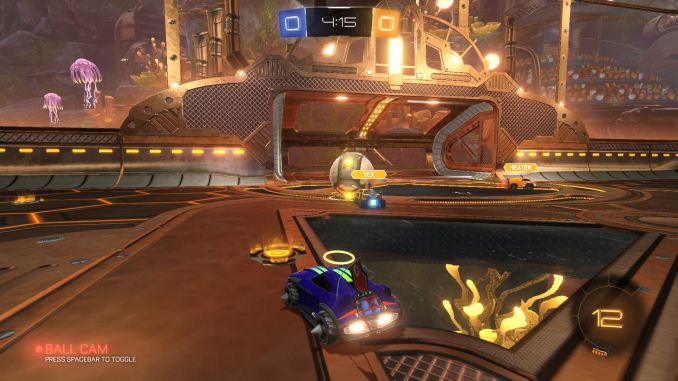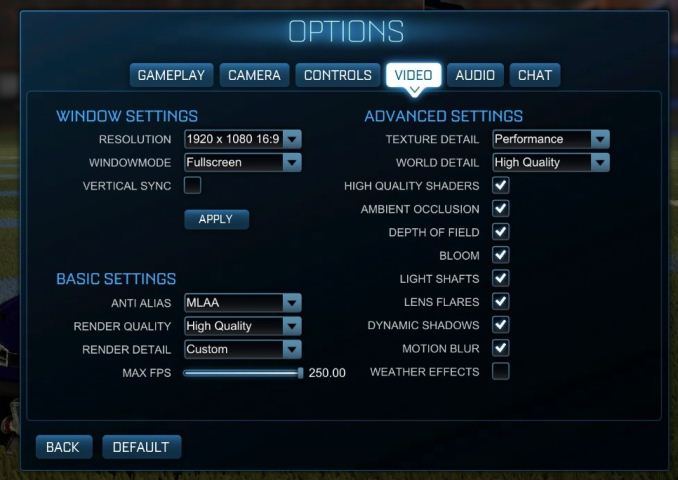The AMD 2nd Gen Ryzen Deep Dive: The 2700X, 2700, 2600X, and 2600 Tested
by Ian Cutress on April 19, 2018 9:00 AM ESTRocket League
Hilariously simple pick-up-and-play games are great fun. I'm a massive fan of the Katamari franchise for that reason — passing start on a controller and rolling around, picking up things to get bigger, is extremely simple. Until we get a PC version of Katamari that I can benchmark, we'll focus on Rocket League.
Rocket League combines the elements of pick-up-and-play, allowing users to jump into a game with other people (or bots) to play football with cars with zero rules. The title is built on Unreal Engine 3, which is somewhat old at this point, but it allows users to run the game on super-low-end systems while still taxing the big ones. Since the release in 2015, it has sold over 5 million copies and seems to be a fixture at LANs and game shows. Users who train get very serious, playing in teams and leagues with very few settings to configure, and everyone is on the same level. Rocket League is quickly becoming one of the favored titles for e-sports tournaments, especially when e-sports contests can be viewed directly from the game interface.
Based on these factors, plus the fact that it is an extremely fun title to load and play, we set out to find the best way to benchmark it. Unfortunately for the most part automatic benchmark modes for games are few and far between. Partly because of this, but also on the basis that it is built on the Unreal 3 engine, Rocket League does not have a benchmark mode. In this case, we have to develop a consistent run and record the frame rate.
Read our initial analysis on our Rocket League benchmark on low-end graphics here.
With Rocket League, there is no benchmark mode, so we have to perform a series of automated actions, similar to a racing game having a fixed number of laps. We take the following approach: Using Fraps to record the time taken to show each frame (and the overall frame rates), we use an automation tool to set up a consistent no-bot match on easy, with the system applying a series of inputs throughout the run, such as switching camera angles and driving around.
It turns out that this method is nicely indicative of a real match, driving up walls, boosting and even putting in the odd assist, save and/or goal, as weird as that sounds for an automated set of commands. To maintain consistency, the commands we apply are not random but time-fixed, and we also keep the map the same (Aquadome, known to be a tough map for GPUs due to water/transparency) and the car customization constant. We start recording just after a match starts, and record for 4 minutes of game time (think 5 laps of a DIRT: Rally benchmark), with average frame rates, 99th percentile and frame times all provided.
The graphics settings for Rocket League come in four broad, generic settings: Low, Medium, High and High FXAA. There are advanced settings in place for shadows and details; however, for these tests, we keep to the generic settings. For both 1920x1080 and 4K resolutions, we test at the High preset with an unlimited frame cap.
All of our benchmark results can also be found in our benchmark engine, Bench.
MSI GTX 1080 Gaming 8G Performance
1080p



4K
















545 Comments
View All Comments
SaturnusDK - Thursday, April 19, 2018 - link
Surely you mean widening the performance gap. It was already ahead in professional and multi-threaded workloads. Now it's miles ahead.MajGenRelativity - Thursday, April 19, 2018 - link
I was referring to single-threaded performance. As for multi-threaded workloads, you are rightfallaha56 - Thursday, April 19, 2018 - link
Like which ones?After the Spectre2 patch the Intel scores have been hammered...
And no doubt with proper default settings on MCE as well
jjj - Thursday, April 19, 2018 - link
Very odd choice to only include the Intels with high clocks in the charts, it's like you wanted to put all Intels at top in ST results, make it look better than it is.Luckz - Monday, April 23, 2018 - link
I'm afraid there are physical space limits regarding how much hardware Ian can fit in his domain. It's been popular to recycle scores from previous tests among sites, but after "Smeltdown" (and with Nvidia drivers being all over the place) it doesn't work that way right now. In an ideal world you'd compare five or ten different setups, sure.But then you'd not just want 8400 @ B360 but also 8700k OC, 2600k OC, 4770k OC, etc...
T1beriu - Thursday, April 19, 2018 - link
Typo: "Cycling back to that Cinebench R15 nT result that showed a 122% gain". I think the gain is just 22%.SirCanealot - Thursday, April 19, 2018 - link
Wow. I'm actually excited to read a review for the first time in a long time! Fantastic review as usual!I'm still sitting on my 3770k @ 4-4-4.7ghz and I'm likely to try delidding for fun and see if I can push it any more. But this review makes me excited to look forward to perhaps building a Ryzen 2/3 (whatever the heck they name it) this time next year!
AMD has caught up to Intel another vital few paces here! If Intel sits on their butts again next year and AMD can do the same thing next year, this is going to get very, very interesting :)
SmCaudata - Thursday, April 19, 2018 - link
I'm sitting on a 2500k. The geek in me wants to upgrade, but I've really no need until Cyberpunk finally releases. Maybe zen 5 by that time.Lolimaster - Thursday, April 19, 2018 - link
You can upgrade to the new 400 mobos, it will be compatible with any Ryzen released till 2020.Luckz - Monday, April 23, 2018 - link
Four times the threads though, four times.Depends on what you do, of course :)